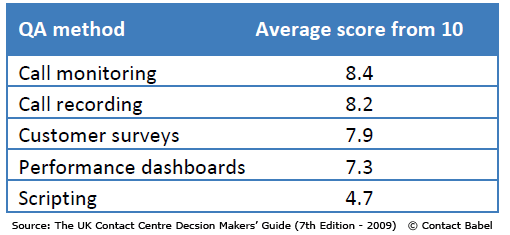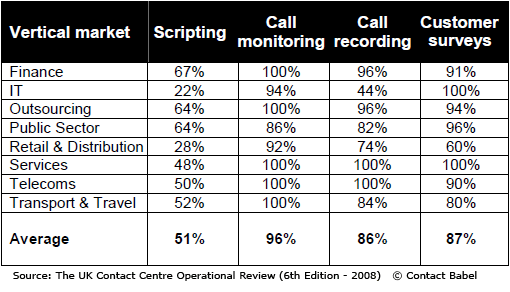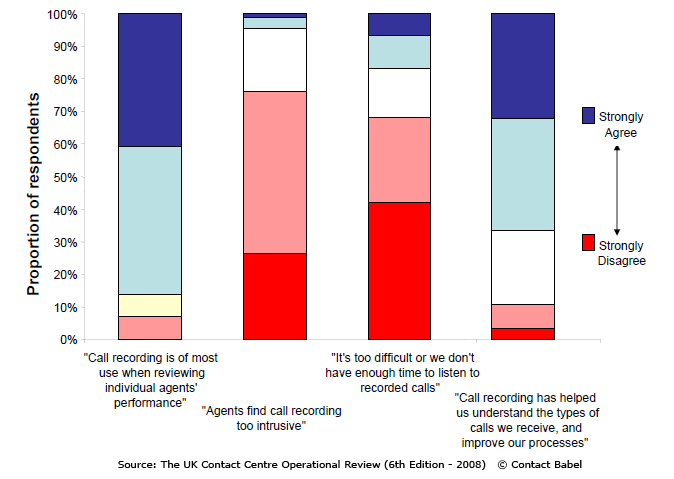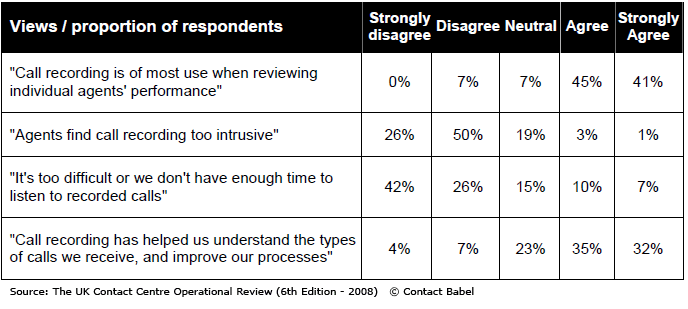Whether quality is an internal or external matter, there are various ways of measuring and tracking this.
Customer surveys are to do with understanding quality after the event, in this case, from the customer’s perspective. Listening-in (call monitoring) and call recording are more about measuring quality against a set of targets or items defined by the contact centre’s management.
Customer Surveys
Customer surveys are seen as an effective QA method, with feedback from real customers being valued especially by those for whom quality is an external issue.
Performance dashboards
Performance dashboards provide a quantitative, real-time view of quality that may include elements such as average handle time, customer satisfaction ratings, first-call resolution, schedule adherence, etc.). As such, they are generally more used within the 45% of operations where quality is defined and measured as an internally focused metric.

Call Recording
Directly checking what an agent has actually said – through real-time call monitoring and post-call reviews of recordings – are seen as the most effective ways of quality assurance, providing the supervisors with touch-points of real conversations, and these are explored in greater depth within the next section.
Scripting
Scripting has a bad reputation these days, and is widely seen as disliked by customers and agents alike, and rigid scripting is certainly often counterproductive. In fact, scripting within a unified desktop environment can actually be beneficial to agent and customer alike, supporting complex interactions where multiple systems and media are required.
Applications that define each step of the call interaction flow and present the relevant data to the agent allow agents to take advantage of pull-down menus, on-screen buttons, pop-up windows, inheritance mechanisms and fill-in-the-blank parameters. Scripts guide agents dynamically through dialogues with customers which change as required, while managing contacts, controlling interactions, and updating databases.
Quality Assurance methods by Vertical Market

Views on quality assurance and call recording


“Call recording is of most use when reviewing individual agents’ performance”
Respondents generally agreed – vehemently – that call recording was most of use when reviewing an agent’s specific performance, and thus, training needs.
Although the answer to a later question in this section suggests that the analysis of call recording is throwing up areas for improvement in the wider business, the strongly positive agreement that recording is best used for individuals’ performance reviews suggests that most businesses are undervaluing the analytic side of call recording (finding the patterns and anomalies that show where the message or process can be improved).
Agent performance can be reviewed in real time through call monitoring and scoring, whereas the wider understanding of call types and results is something that has to be done through sophisticated call analytics, and is something which in our opinion is of far more potential benefit to a business than agent performance reviews.
“Agents find call recording too intrusive”
There have been questions in the past about the agents’ opinions of call recording – specifically, its intrusiveness – but few respondents believe that agents now have a problem with being recorded.
“It’s too difficult or we don’t have enough time to listen to recorded calls”
Despite the time required to listen to calls and score them accordingly for QA purposes, few respondents are unwilling or unable to spend this time, prioritising it within the overall tasks of the contact centre. Respondents are aware that call recording and analytics can identify any issues with individual agents (and possibly, wider business processes) which more than repay the time required.
“Call recording has helped us understand the types of calls we receive, and improve our processes”
Two-thirds of respondents agree that call recording has offered them a chance to improve their business processes through understanding why they are receiving calls.
This has allowed them to identify patterns and reduce the number of unnecessary calls (for example, by placing the answers to a frequently-asked question on the website or in the IVR announcement), or to fix a broken process that customers had identified.
Click here for our 59 Call Centre Quality Assurance Tips
Further reading
- Call Quality Monitoring
- Typical Quality Monitoring features
- Using Call Recordings To Coach Staff
- Top tips for Call Quality Monitoring
Contributors
Steve Morrell of Contact Babel
Author: Jonty Pearce
Published On: 14th Mar 2010 - Last modified: 11th Apr 2024
Read more about - Customer Service Strategy, ContactBabel, Quality, Steve Morrell















Great source of information in one website…..would consider it essential reading for any one who either does not have or just about to start a QA programme in their contact centre.
Do you have any recommendations or industry standards/benchmarks as to level of agent monitoring.